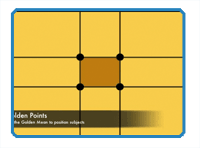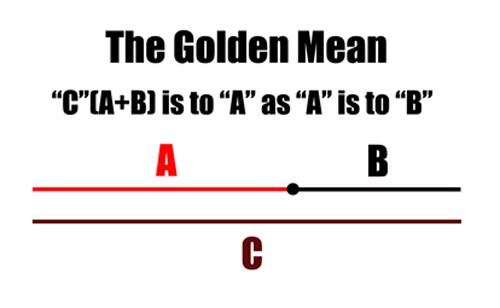
By Matt Fussell
Creating good compositions in your artwork does not have to be guesswork. In fact, it should not in any way be guesswork. This page is devoted to part three of our study on compositional devices in art. In part one, we looked at Plato's Rule . In part two, we explored how to use eye movement to create good composition. Next, we'll look at using the Golden Mean, or Golden Ratio to create good composition in art. We'll also take a look at it's cousin, The Rule of Thirds.
The Golden Mean is basically a mathematical ratio. Mathematicians will argue that it was discovered by Pythagoras while others give credit to Vitruvius. Simply put, this ratio can be broken down in the following example...

Now how can we use the Golden Mean to create artwork? Well, logically we can use it when we crop our images or frame our canvases. However, there is another practical way to use the Golden Mean in our artwork. It is to find the "Golden Points" through the Golden Mean. The Golden Points are places within the picture plane to place subjects or objects in a way that will result in a more aesthetic composition.
The video below highlights how to find and use these Golden Points create good composition from them. This video also addresses the cousin of the Golden Mean-The Rule of Thirds. It is my opinion that The Rule of Thirds is a derivative of the Golden Points. If the Golden Mean is a bit too confusing, The Rule of Thirds may be a good substitute.
The following video explains how to use The Golden Mean and The Rule of Thirds in your artistic compositions...
Video Transcription
welcome back to another video tutorial brought to you by TheVirtualInstructor.com. Today, we are finishing up our compositional studies series with part three where we are talking about The Golden Mean. Also called The Golden Proportion, and the rule of thirds. This image that you are looking at here was made by Leonardo DaVinci, and he uses The Golden Mean. Well, what is The Golden Mean? The Golden Mean is a mathematical ratio. And basically it says that "c" (which is a+b) is proportional to "a" the same way "a" is to "b". Now, how can we use this in our artworks? Well, we can use it when we crop our picture planes, in one way. But, we can also use it when we determine the position of subjects or objects in our work. Here's the image that we just saw by Leonardo DaVinci. You can see the way that he placed objects on here as relative to The Golden Mean. Now, if we use The Golden Mean to split up our picture plane, like seen here. We create what is called "Golden points". Now, golden points are places in our picture plane where we can place important subjects. So we can use The Golden Mean not only to crop our picture plane, but also to determine where we are going to place subjects. Now let's look at three pieces of artwork, and see if we can determine which one uses The Golden Mean. Here's the first image. Here's the second composition. And here's the third. Looking back at our graph of the golden points, do any of those compositions seem that they used the golden points? it wasn't the first one. The first one placed the subject matter dead center. That's not a very good composition for the subject matter. The second one put the subject matter to the far right. Which made it heavy on the right. If you said the third one, then you were correct. The third one made use of the bottom right golden point that was created by using The Golden Mean. Here it is in a graph. The golden point is created by using the The Golden Ratio, or The Golden Mean. Here's our image again, and if we lay on top of it the graph of the golden point, you can see that where the lighthouse meets the horizon line is where the golden point is. This is going to create a more aesthetically pleasing composition. Now, using The Golden Mean can be a bit complicated because there is some math involved. If it's too much for you, you may choose to use the cousin of The Golden Mean, or The Rule of Thirds. The Rule of Thirds is where you take a picture plane and you break it into three. You break it into thirds. This is shown by the graph that is on your screen now. If this was your picture plane and you broke it up into thirds, you would have something like this. Now, let's look at a composition. Here's a silhouette of a tree, and there is a horizon line. This image uses The Rule of Thirds to create the composition. Obviously, this is not a finished piece of artwork. Instead, it's just here to show you The Rule of Thirds. If we take the graph of The Rule of Thirds that we had before, and lay it over the top, you can see that the tree is on the left third, and the horizon line is on the bottom third. These objects are placed there to create a more aesthetically pleasing composition. So, you can use The Golden Mean, you can use The Rule of Thirds. All to create a better composition, a more aesthetically pleasing composition. This has been another video tutorial brought to you by TheVirtualInstructor.com.
Here are some more art lessons that you may like...